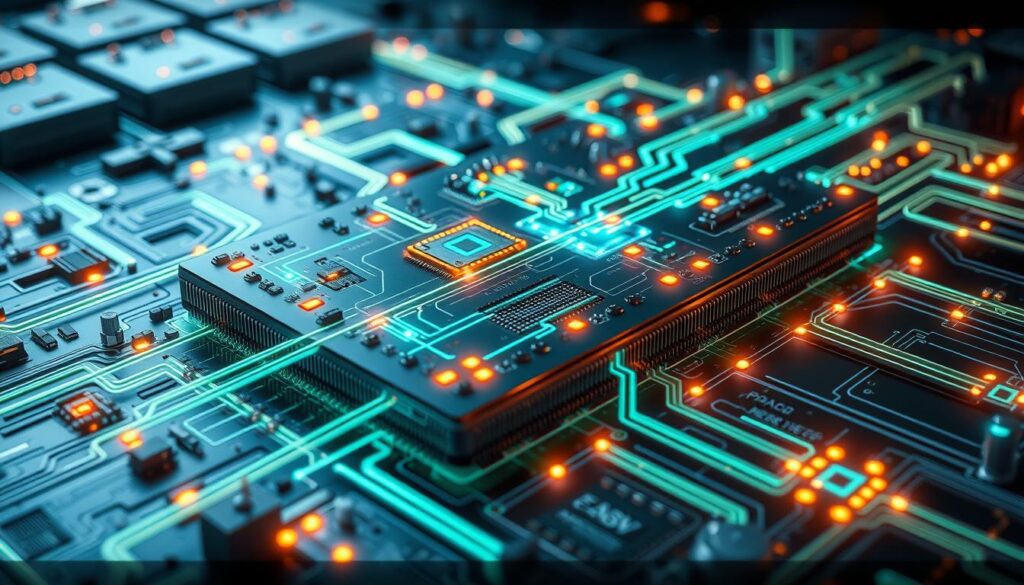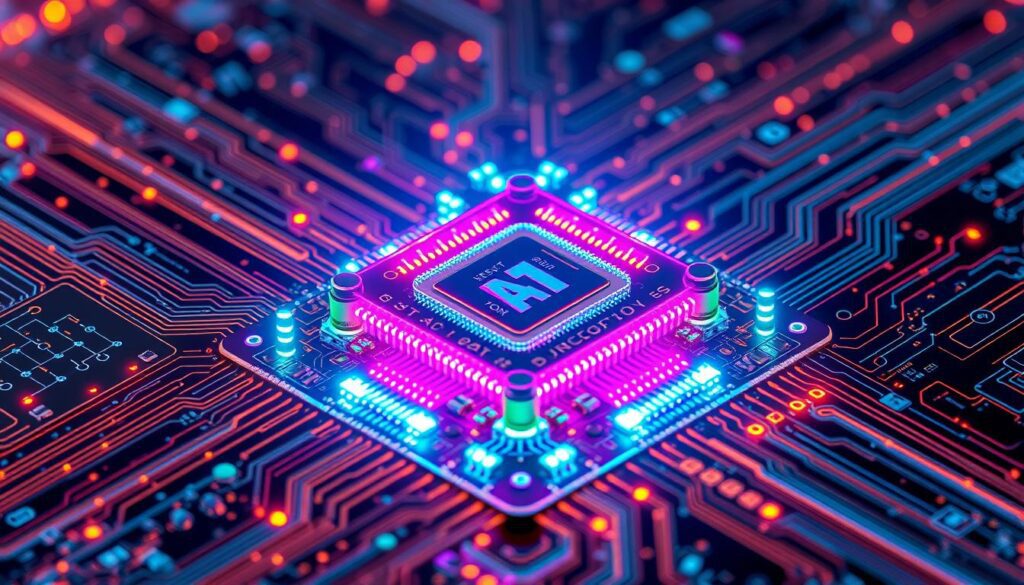The world of technology is changing fast. We need more high-performance computing and AI devices than ever. The design of integrated circuits (ICs) has become very important.
We’ve had to change how we design ICs for AI/ML chips and other high-performance devices. This change is crucial for meeting new challenges and needs.
Optimizing power, performance, and area is key. We also need these systems to be reliable and scalable. Every step in the design process is tailored for AI and machine learning hardware.
In this article, we’ll look at AI chip architecture and design flow for machine learning hardware. We’ll also explore the important parameters for physical implementation. Understanding physical design for AI/ML chips and high-performance computing opens up new possibilities. It helps technology fit seamlessly into our lives.
Table of Contents
Understanding the Fundamentals of Physical Design for AI chips
The need for powerful and efficient AI/ML hardware is growing fast. The details of physical design are now key. We’ll look at the basics that shape these advanced circuits.
Key Components of AI Chip Architecture
At the heart of AI chips are special processing units. These are called neural processing units (NPUs) or tensor processing units (TPUs). They speed up tasks in machine learning and deep learning.
These units work with memory, interconnects, and power management. Together, they form the core of AI chip architecture.
Design Flow Considerations for Machine Learning Hardware
The design process for AI/ML hardware is different from traditional ASIC design. It involves mapping neural networks efficiently and optimizing memory. Managing data movement is also key.
Adding new hardware accelerators and making software frameworks work well adds complexity. But it’s worth it for better performance.
Critical Parameters in Physical Implementation
When making AI chips, we must focus on key aspects. These include managing power, optimizing clock trees, and planning the layout of components. We also need to think about thermal management and fast network design.
By understanding these basics, we can make AI chips work better. This opens up new possibilities in machine learning and artificial intelligence.
Power Distribution Networks in High-Performance Computing Devices
In high-performance computing, power distribution networks are key. They make sure AI/ML chips work well and reliably. These systems give the right voltage and current to the chip, avoiding voltage drops and keeping power steady.
Creating strong power networks for AI chips is a big challenge. Voltage drops can cause timing problems and slow performance. Bad power integrity can lead to instability and failures.
To solve these issues, engineers use many strategies. They study the chip’s power needs, place power rails and vias wisely, and use advanced power management. This helps control voltage and current levels.
By focusing on power distribution networks, we can make sure high-performance devices work well. This includes AI accelerators, which are crucial for important tasks.

Important things to think about in designing power networks for AI/ML chips are:
- Accurate modeling and simulation of power consumption patterns
- Optimization of power rail routing and placement
- Effective decoupling capacitor placement and sizing
- Implementation of adaptive voltage scaling and power gating techniques
- Thermal management strategies to mitigate hot spots and ensure uniform power delivery
By tackling these key points, we can make sure high-performance computing devices have strong power networks. These networks can handle the growing needs of today’s computing tasks.
Clock Tree Synthesis Optimization for ML Accelerators
When making ML accelerators, it’s key to optimize the clock tree synthesis (CTS). This ensures power is distributed well and timing is precise. We look at new ways to use ML hardware to make CTS better.
Advanced Clock Gating Techniques
Clock gating is a big help in saving power in digital designs. For ML accelerators, we use smart clock gating. It turns off unused clock domains, cutting down power use without hurting speed.
Timing Closure Strategies
Getting timing right in ML chips is tough. We use strong timing closure plans. These plans work with ML hardware’s special needs, like many processing units and fast data sharing.
Low-Latency Network Design
ML accelerators need fast data paths for top performance. We use new network designs for quick data moves. This makes sure important info flows well, boosting system speed.
| Technique | Description | Benefits |
|---|---|---|
| Clock Tree Synthesis Optimization | Tailoring clock tree synthesis to the specific needs of ML accelerators | Improved power efficiency, precise timing synchronization |
| Advanced Clock Gating | Intelligent clock gating methods that selectively disable unused clock domains | Significant dynamic power reduction without performance impact |
| Timing Closure Strategies | Robust timing closure solutions for complex ML chip architectures | Reliable synchronization and performance optimization |
| Low-Latency Network Design | Innovative interconnect solutions for efficient data transfer in ML accelerators | Enhanced system performance and responsiveness |

Floor Planning Strategies for Neural Network Acceleration
Optimizing neural network acceleration requires careful floor planning. We focus on die area optimization to make chips more efficient. This allows us to fit the complex circuits needed for machine learning.
Die Area Optimization Techniques
We aim to fit as much computing power as possible in the chip’s space. We arrange blocks like processing elements and memory to save space. This helps data flow smoothly.
Placement and Routing Considerations
AI/ML circuit placement and routing are key to performance. We look at things like interconnect lengths and power distribution. This ensures the chip works efficiently.
Thermal Management Solutions
Neural network acceleration creates a lot of heat. We use advanced cooling methods to keep the chip running well. This includes special floorplanning and power management to prevent overheating.

